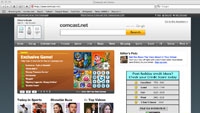Cable operators develop online strategies to counteract churn

Cable television operators, who have seen thousands of subscribers turning off their traditional services in recent weeks to watch programming on the Internet, are reacting to the challenge.
In an attempt to stem the tide of viewers seeking free or very low-cost television alternatives on the Internet, the cable operators are negotiating with content owners to create their own Internet platform. The stakes are high, and some of the biggest names in the business, including Comcast, Time Warner Cable, Cox Communications and Cablevision, are involved.
Operators are proceeding with caution because their core business model is at stake. As viewers find more free content on the Internet, they are canceling cable services that can cost more than $100 a month. In the fourth quarter alone, Comcast lost 233,000 basic subscribers in the deteriorating economy.
Most cable providers now see their fledgling Internet efforts as supplemental services to existing subscribers — an extension of the concept that allows viewers to watch programming anyplace, anytime they choose. At this early stage, however, negotiations are fluid, and nothing is set in stone.
It easy to see how cable operators feel threatened by the Internet video trend. Leichtman Research Group released data in February that found 34 percent of adults who go online at home watch videos over the Internet at least every week. That’s up from 25 percent two years ago.
Content rights usage
One problem for cable operators is they pay little or nothing for the rights to put network or local television on their systems. For this reason, the operators haven’t been able to stop broadcasters from offering their programs online.
For other content — premium programming where cable operators pay the creators for exclusivity — Internet play has not yet been a major problem. That, however, could change quickly. Under consideration is whether cable could get a subscription fee for online viewing of specific programs while offering the same program on cable.
The professional video industry's #1 source for news, trends and product and tech information. Sign up below.
Online competition
While the cable industry considers its options, Web sites like Hulu, a joint venture of NBC and Fox that streams free television programs, is booming. Multiple streams of news from major global organizations like CNN are already free over the Internet. And, for movies and other television fare, there are lower-cost pay services like Netflix and iTunes.
Netflix, which began as a DVD rental service, now offers 12,000 movies and television episodes without commercials online through a small box manufactured by Roku. After a $99 fee to purchase the box, Netflix customers paying as little as $8.99 a month can watch unlimited movies on a standard television set.
Since the introduction of the Roku box last year, Netflix is also offering the service through Blu-ray players, TiVo and Xbox 360 systems, as well as on computers. Soon, the service will be available to everyone, without the need to rent DVDs, Netflix said. Video quality, though not true high-definition, has vastly improved and works well on fast broadband connections.
Apple’s iTunes, a competing service, does not require a box to watch programming on computers or an Apple TV device to connect the video to conventional television sets. Apple sells more than 30,000 TV episodes from the four networks and 2500 films, including more than 600 in HD. Most shows cost between $2 and $3 to view, and users can purchase entire seasons of preferred TV series on a subscription basis.
The idea of purchasing subscriptions to certain series or performers is an intriguing one for cable. Because the concept is so new, there’s little evidence regarding its potential success or value. Combined with the increase in the number of outlets that might offer such programming, the cable industry is approaching the whole concept with great trepidation.
Cutting the cord
Though thousands of viewers have cut the cable cord, it’s not yet a widespread phenomenon. Cable knows it is following in the footsteps of the music and publishing industries in making such a decision about the Web. Both of those industries paid enormously for past missteps. Newspapers that retained their print business models and gave away their product on the Internet are now threatened with extinction. No one wants to pay for news on the Web.
The cable operators are also aware that competitors, such as Verizon’s FiOS fiber service and DIRECTV’s direct-to-view satellites, will follow their lead on the Internet. Once cable makes its move, the operators know they will have direct competition from a variety of companies with all sorts of configurations and prices.
What the cable industry also doesn’t want is its own broadband Internet pipes used to supply the television programming of competitors. The cable industry refers to this as “over-the-top” service. Though no such service has yet to take off in a significant way, it’s easy to imagine small programmers using cable’s broadband connections to sell cheaper bundles of the same programming the cable company already offers.
The good news for cable is that American television viewers have voted with their wallets and demonstrated they are willing to pay for television. Internet viewing, though growing rapidly, is still a nascent medium and no major threat to the status quo — yet.
Perhaps the great variable in this scenario is the state of the economy. Should it improve quickly, some of the pressure will be off the cable industry. However, if the economic downturn worsens, high cable television bills could be among the first items Americans will cut.
That could drive the kind of change cable wants to avoid.
